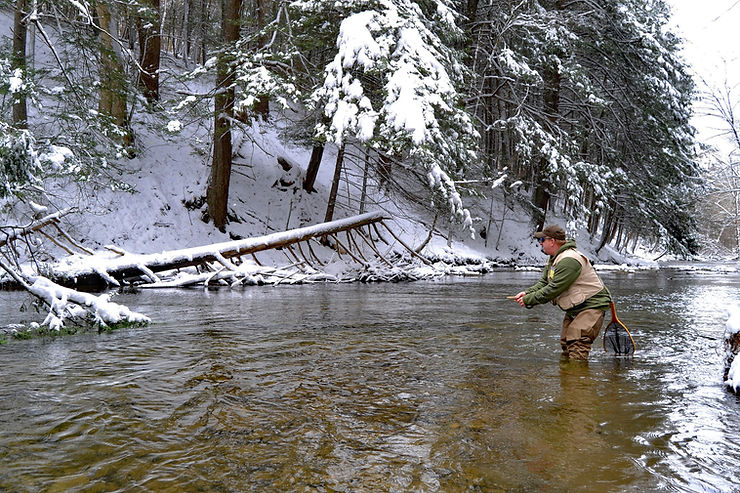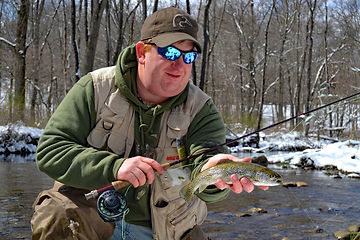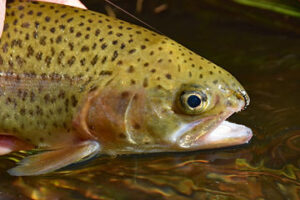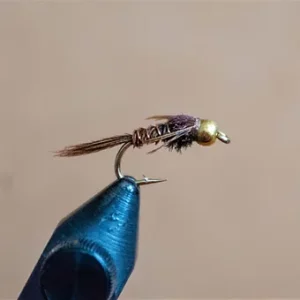Fly Fishing for Winter Trout

A mid-January warm front got me thinking spring. And by “warm front,” I mean that for the first time in almost two weeks, daytime temperatures got above freezing. Still, it was enough to make me load up the truck and visit one of my favorite streams to see if the trout were biting. I was not disappointed.
Winter trout fishing can be hit or miss. The main differences between fishing now and other times of year are that fish are less aggressive and feeding windows tend to be shorter. Trout will be most active during the warmest parts of the day, so there’s no need to hit the water at the crack of dawn, unless the forecast shows a cold front moving in later in the day. In that situation, the morning bite can be quite good ahead of the front.
For the most part, though, my best experiences happen mid-morning and later, after the sun gets high enough to hit the water. In the winter, sunlight alone can have a positive effect, and a one or two degree rise in water temperature can be a big deal. Nymphs and other baitfish get active and trout soon begin to feed, which is exactly what happened that January day. The heavy overcast of the morning cleared out by noon, and over the next four hours, I landed half a dozen trout. It was a satisfying and peaceful way to spend a winter’s day.
Catching winter trout calls for a slight change in tactics, especially in regards to presentation. Although I use the same fly rod, reel, line, and leaders that I would any other time of year, in the winter I fish much slower. Painfully slow. Sounds easy enough until you’re out there and the cold starts sinking in. The body’s natural tendency is to move faster to create heat. But more often than not, if I’m not getting any strikes, it’s because I’m fishing too fast.
Fishing slow means working the water over more methodically than I would any other time. If fish are really sluggish, sometimes you have the put the fly or bait right on their noses to get them to hit. Often that requires multiple drifts through prime holding water. The addition of a small split shot above the fly can also help slow down your presentation and allow it to hang in the fish’s feeding lane that extra moment or two needed to induce a strike.

There are two schools of thought regarding winter fly selection. The first one recommends using flies slightly larger than normal. The theory is that a heartier meal will better tempt sluggish trout to hit. At times, that’s definitely true. I’ve seen winter days where dead-drifting a size 8 Woolly Bugger worked when smaller nymphs produced nothing. I’ve also had great success crawling oversized streamers along the bottoms of big pools. Once again, the trick is to fish them as slowly as possible.
The second school of thought suggests using smaller patterns, and generally speaking, these will produce the most consistent winter action. The main reason, I believe, is because tiny mayfly and stonefly nymphs and midges are the most abundant food sources available in winter.
My go-to flies for winter trout are Zebra Midges, Pheasant Tail Nymphs, Rainbow Warriors, and WD40s in sizes 16 to 22, but I do carry a selection of Woolly Buggers and streamer patterns just in case. Also, this time of year, tandem rigs fished under a strike indicator can be deadly.

The advantage of the tandem rig is that you can quickly find out what fish prefer that particular day, and fishing multiple flies, of course, gives you multiple chances to catch fish on every drift. Winter trout can be selective, so don’t be afraid to experiment with different combinations of flies as some will produce better than others in certain situations.
If you’re having trouble with ice clogging your guides, try greasing them with fly floatant, Chapstick, and even cooking spray. If those don’t work, Loon Outdoors makes a product called Stanley’s Ice-Off Paste, which is specifically designed for fishing rods. Constantly breaking ice from the guides can be frustrating and time-consuming, so these products are definitely worth their weight.
Comfort goes a long way toward a good experience, too. Watch the weather forecast and know what to expect. I dress in layers and load my fishing vest and pockets with handwarmers, and I’m not afraid to take a break and go back to the truck to warm up a bit. All of these things contribute to an enjoyable day of winter trout fishing.
Sign up for the Dark Skies Fly Fishing e-newsletter
It's free, delivered to your inbox approximately three times each month. Your information is always kept private and used for the sole purpose of keeping you up to date on blog posts and specials in the online store.
Sign Up NowShop The Flies Mentioned In This Post
-
Flies
Pheasant Tail Nymph
$1.65 Select options This product has multiple variants. The options may be chosen on the product pageRated 0 out of 5 -
Flies
Woolly Bugger
$1.65 Select options This product has multiple variants. The options may be chosen on the product pageRated 0 out of 5 -
Egg Patterns
Y2K
$1.65 Select options This product has multiple variants. The options may be chosen on the product pageRated 0 out of 5



